| Listing 1 - 10 of 23 | << page >> |
Sort by
|
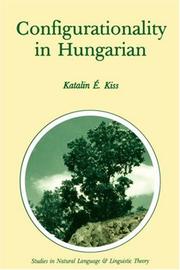
ISBN: 9027719071 9027724563 9400937032 Year: 1987 Publisher: Dordrecht,Boston : D. Reidel Pub. Co.,
Abstract | Keywords | Export | Availability | Bookmark
 Loading...
Loading...Choose an application
- Reference Manager
- EndNote
- RefWorks (Direct export to RefWorks)
Hungarian language --- Grammar --- Hongrois --- Syntax --- Generative grammar --- Syntaxe --- Grammaire générative --- Grammaire générative
Book
ISBN: 9780198709855 9780191780165 0191780162 9780191019784 019101978X 0198709854 Year: 2014 Publisher: Oxford Oxford University Press
Abstract | Keywords | Export | Availability | Bookmark
 Loading...
Loading...Choose an application
- Reference Manager
- EndNote
- RefWorks (Direct export to RefWorks)
This publication adopts a generative framework to investigate the diachronic syntax of Hungarian, one of only a handful of non-Indo-European languages with a documented history spanning more than 800 years. It focuses particularly on the restructuring of Hungarian syntax from head-final to head-initial and the resultant changes that occurred.
Hungarian language --- Historical linguistics --- Grammar --- FOREIGN LANGUAGE STUDY / Hungarian. --- Grammar, Comparative and general --- Syntax. --- Uralic and Basque Languages & Literatures --- Languages & Literatures --- Syntax
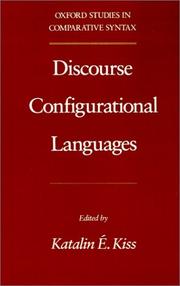
ISBN: 0195088344 0195088336 1280534877 0195358503 9780195358506 9780195088335 9786610534876 661053487X 9780195088342 0197721540 9781280534874 Year: 1995 Volume: *2 Publisher: New York Oxford University Press
Abstract | Keywords | Export | Availability | Bookmark
 Loading...
Loading...Choose an application
- Reference Manager
- EndNote
- RefWorks (Direct export to RefWorks)
Generatieve spraakkunst --- Generative grammar --- Grammaire générative --- Grammaire transformationnelle --- Grammar [Comparative and general ] -- Derivation --- Grammar [Generative ] --- Grammar [Transformational ] --- Grammar [Transformational generative ] --- Grammatica [Generatieve ] --- Grammatica [Transformationele ] --- Spraakkunst [Generatieve ] --- Spraakkunst [Transformationele ] --- Transformational generative grammar --- Transformational grammar --- Transformationele grammatica --- Transformationele spraakkunst --- Transformationele taaltheorie --- Grammar, Comparative and general --- Grammaire générative --- Sujet et prédicat --- Topic and comment --- Functional sentence perspective (Grammar) --- Predicate and subject (Grammar) --- Subject and predicate (Grammar) --- Theme and rheme --- Topic and comment (Grammar) --- Focus (Linguistics) --- Grammar, Generative --- Grammar, Transformational --- Grammar, Transformational generative --- Psycholinguistics --- Subject and predicate --- Syntax --- Derivation --- Grammar [Comparative and general ] --- Generative grammar. --- Topic and comment. --- Linguistics --- Philology
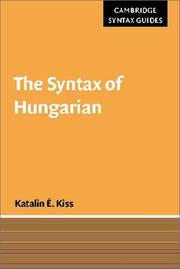
ISBN: 0521660475 0521669391 9780521660471 9780521669399 1107128382 1280432535 0511148461 0511305354 0511177976 0511048513 0511755082 9780511755088 0511020651 9780511020650 9780511148460 9780511048517 9781107128385 9781280432538 9780511305351 9780511177972 Year: 2002 Publisher: Cambridge Cambridge University Press
Abstract | Keywords | Export | Availability | Bookmark
 Loading...
Loading...Choose an application
- Reference Manager
- EndNote
- RefWorks (Direct export to RefWorks)
Clearly written and comprehensive in scope, this is an essential guide to syntax in the Hungarian language. It describes the key grammatical features of the language, focusing on the phenomena that have proved to be theoretically the most relevant and have attracted the most attention. The analysis of Hungarian in the generative framework since the late Seventies has helped to bring phenomena which are non-overt in the English language into the focus of syntactic research. As Kiss shows, its results have been built into the hypotheses that make up universal grammar. The textbook explores issues at the centre of theoretical debates including the syntax and semantics of focus, the analysis of quantifier scope, and negative concord. This useful guide will be welcomed by students and researchers working on syntax and those interested in Finno-Ugric languages.
Hungarian language --- 809.451 --- Syntax --- Hongaars --- Syntax. --- Arts and Humanities --- Language & Linguistics
Digital
ISBN: 9781402047558 Year: 2008 Publisher: Dordrecht Springer
Abstract | Keywords | Export | Availability | Bookmark
 Loading...
Loading...Choose an application
- Reference Manager
- EndNote
- RefWorks (Direct export to RefWorks)
Lexicology. Semantics --- Linguistics --- semantiek --- syntaxis --- linguïstiek
Book
Year: 2007 Publisher: Dordrecht Springer
Abstract | Keywords | Export | Availability | Bookmark
 Loading...
Loading...Choose an application
- Reference Manager
- EndNote
- RefWorks (Direct export to RefWorks)
Book
ISBN: 963054184X Year: 1987 Publisher: Budapest Akademiai Kiado
Abstract | Keywords | Export | Availability | Bookmark
 Loading...
Loading...Choose an application
- Reference Manager
- EndNote
- RefWorks (Direct export to RefWorks)
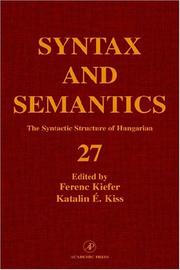
ISBN: 0126135274 9004373179 Year: 1994 Volume: 27 Publisher: Emerald
Abstract | Keywords | Export | Availability | Bookmark
 Loading...
Loading...Choose an application
- Reference Manager
- EndNote
- RefWorks (Direct export to RefWorks)
Hungarian syntax has played a vital, albeit much debated role in linguistic theory since the early 1980s. Volume 27 of "Syntax and Semantics" is the result of a project on Hungarian syntax launched in the early 1980s at the Research Institute for Linguistics of the Hungarian Academy of Sciences. The volume illuminates relevant and insightful aspects of Hungarian syntax. It assumes the basic theoretical claims and the basic methodology of generative linguistic theory, and shows that descriptive grammar is best approached by posing theoretically interesting questions. It features comprehensive coverage of Hungarian syntax and presents a complete analysis of salient questions and theories. It offers new insights into Hungarian syntax and discusses the important role Hungarian syntax has played in linguistic theory throughout the past decade.
Hungarian language --- Grammar --- Hongrois --- Syntax --- Syntaxe --- -Magyar language --- Finno-Ugric languages --- -Syntax --- Syntax. --- Hungarian language. --- Magyar language
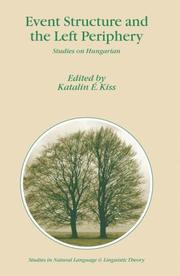
ISBN: 1280611707 9786610611706 140204755X 1402047533 1402047541 1281118508 Year: 2006 Publisher: Dordrecht : Springer,
Abstract | Keywords | Export | Availability | Bookmark
 Loading...
Loading...Choose an application
- Reference Manager
- EndNote
- RefWorks (Direct export to RefWorks)
This book provides substantial new results in a novel field of research examining the syntactic and semantic consequences of event structure. The studies of this volume examine the hypothesis that event structure correlates with word order, the presence or absence of the verbal particle, the [+/- specific] feature of the internal argument, aspect, focusing, negation, and negative quantification, among others. The results reported concern the telicising vs. perfectivizing role of the verbal particle; the syntactic and semantic differences of verbs denoting a delimited change, and those denoting creation or coming into being; evidence of viewpoint aspect in a language with no morphological viewpoint marking; the aspectual role of non-thematic objects; the source of the ‘exhaustive identification’ function of structural focus; the interaction of negation and aspect etc.
Hungarian language --- Syntax. --- Grammar. --- Grammar, Comparative and general. --- Semantics. --- Theoretical Linguistics. --- Formal semantics --- Semasiology --- Semiology (Semantics) --- Comparative linguistics --- Information theory --- Language and languages --- Lexicology --- Meaning (Psychology) --- Comparative grammar --- Grammar --- Grammar, Philosophical --- Grammar, Universal --- Philosophical grammar --- Linguistics --- Philology --- Grammar, Comparative --- Linguistics. --- Linguistic science --- Science of language --- Grammar, Comparative and general Syntax --- Syntax
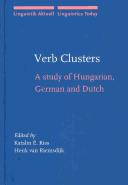
ISBN: 9027227934 1588115070 9786612160516 1282160516 902729559X 9789027227935 9789027295590 9781282160514 6612160519 Year: 2004 Volume: 69 69 Publisher: Amsterdam Philadelphia J. Benjamins
Abstract | Keywords | Export | Availability | Bookmark
 Loading...
Loading...Choose an application
- Reference Manager
- EndNote
- RefWorks (Direct export to RefWorks)
Many languages have constructions in which verbs cluster. But few languages have verb clusters as rich and complex as Continental West Germanic and Hungarian. Furthermore the precise ordering properties and the variation in the cluster patterns are remarkably similar in Hungarian and Germanic. This similarity is, of course, unexpected since Hungarian is not an Indo-European language like the Germanic language group. Instead it appears that the clustering, inversion and roll-up patterns found may constitute an areal feature. This book presents the relevant language data in considerable detail, taking into account also the variation observed, for example, among dialects. But it also discusses the various analytical approaches that can be brought to bear on this set of phenomena. In particular, there are various hypotheses as to what is the underlying driving force behind cluster formation: stress patterns, aspectual features, morpho- syntactic constraints? And the analytical approaches are closely linked to a number of questions that are at the core of current syntactic theorizing: does head movement exist or should all apparent verb displacement be reduced to remnant movement, are morphology and syntax really just different sides of the same coin?
German language --- Verb phrase. --- Dutch language --- Hungarian language --- Magyar language --- Finno-Ugric languages --- Flemish language --- Netherlandic language --- Germanic languages --- Verb phrase --- German language - Verb phrase.
| Listing 1 - 10 of 23 | << page >> |
Sort by
|

 Search
Search Feedback
Feedback About UniCat
About UniCat  Help
Help News
News